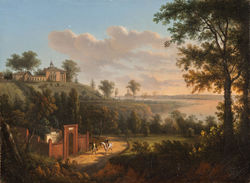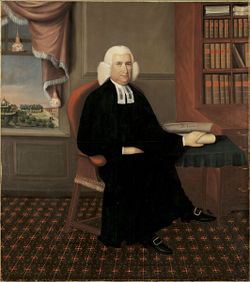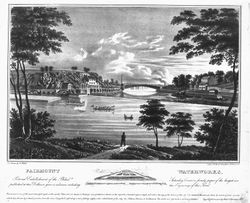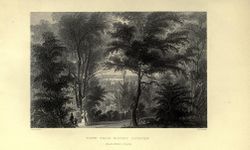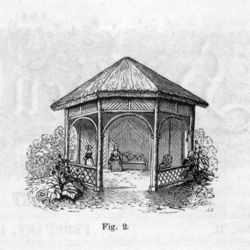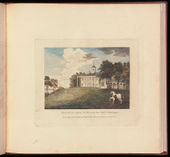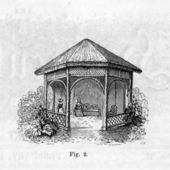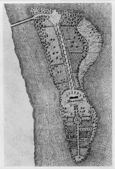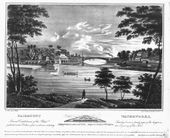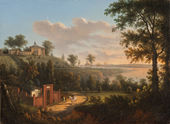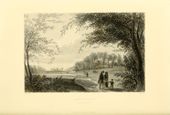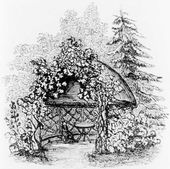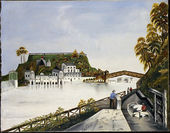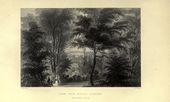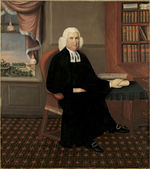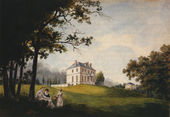Difference between revisions of "Eminence"
m (Usage/Trego and Cleaveland parens edits-year) |
m (Citations/m'mahon and watterston: parens year edit--got rid of pp) |
||
| Line 129: | Line 129: | ||
| − | * M’Mahon, Bernard, 1806, ''The American Gardener’s Calendar'' ( | + | * M’Mahon, Bernard, 1806, ''The American Gardener’s Calendar'' (1806: 59) <ref>Bernard M'Mahon, ''The American Gardener’s Calendar: Adapted to the Climates and Seasons of the United States. Containing a Complete Account of All the Work Necessary to Be Done . . . for Every Month of the Year. . . . '' (Philadelphia: Printed by B. Graves for the author, 1806), [https://www.zotero.org/groups/54737/items/itemKey/HU4JIS9C view on Zotero].</ref> |
: “In other parts are sometimes discovered '''eminences''', or rising grounds, as a high [[terrace]], [[mount]], steep declivity, or other '''eminence''', ornamented with curious trees and [[shrub]]s, with [[walk]]s leading under the shade of trees, by easy ascents to the summit, where is presented to the [[view]], an extensive [[prospect]] of the adjacent fields, buildings, hamlets, and country around, and likewise affording a fresh and cooling air in summer.” | : “In other parts are sometimes discovered '''eminences''', or rising grounds, as a high [[terrace]], [[mount]], steep declivity, or other '''eminence''', ornamented with curious trees and [[shrub]]s, with [[walk]]s leading under the shade of trees, by easy ascents to the summit, where is presented to the [[view]], an extensive [[prospect]] of the adjacent fields, buildings, hamlets, and country around, and likewise affording a fresh and cooling air in summer.” | ||
| Line 157: | Line 157: | ||
| − | * Watterston, George, May 1844, “Landscape Gardening” ( | + | * Watterston, George, May 1844, “Landscape Gardening” (1844: 310) <ref>George Watterston, "Landscape Gardening",''Southern Literary Messenger'', 10 (May) (1844), 306–15, [https://www.zotero.org/groups/54737/items/itemKey/3F6PUXVE view on Zotero].</ref> |
: “Repton conceives that the difference between painting and gardening consists in the following particulars: | : “Repton conceives that the difference between painting and gardening consists in the following particulars: | ||
Revision as of 19:49, February 1, 2018
History
The term eminence, indicating an elevated rise or hill, functioned in landscape design as a site for monuments, dwellings, and other structures, and as a topographic feature in the landscape. While the terms “mound” and “mount” were also used to describe a raised portion of a garden, an eminence generally denoted a natural feature that was larger in scale.
As a building platform for a dwelling or a garden structure, an eminence created the opportunity to view the surrounding landscape from the garden. This raised feature also enhanced the prominence of any structure on it, thus making it visible from a distance (see Prospect and View). Both effects were noted by visitors to Mount Vernon, which William Russell Birch in 1808 described as “founded upon a rocky eminence, a dignified height on the Potomac” [Fig. 1]. Garden structures, such as the tower (proposed in 1831) at Mount Auburn Cemetery in Cambridge, Massachusetts, the rustic pavilion recommended by A. J. Downing (1848), and the fanciful building depicted in the 1790s by Joseph Steward at Dartmouth College [Fig. 2], were placed on eminences to provide a retreat in which to enjoy the prospect.
In addition to their enhanced visual and, by extension, social status, properties built on eminences were more easily defensible in America’s frontier settings and took advantage of cooling breezes in warmer climates. Structures on eminences also offered visual command of an estate, as noted in the 1817 advertisement of a farm in Culpeper County, Virginia. Such surveillance was a vital part of maintaining the plantation labor system of large slave populations. In urban settings, town planners sited key monuments on eminences, making them focal points in the townscape and thus accentuating seats of power. For example, Francis Nicholson in 1694 placed the Anglican church and the colonial Capitol on eminences in his town plan of Annapolis, MD, and Pierre-Charles L’Enfant’s plan for Washington, D.C., was predicated upon an elevated setting for the capitol building.
As a topographical landscape feature, the eminence served as a focal point, a viewing platform, and a backdrop, like the “parklike eminences” in Cincinnati, Ohio, described by Harriet Martineau in 1835. At Mount Auburn Cemetery, the eminence rising 125 feet above the Charles River was described in 1831 by H.A.S. Dearborn as “a prominent and imposing feature in the landscape, of which it becomes the centre.” An eminence, such as the one described by Rev. Manasseh Cutler at Gray’s Tavern in Philadelphia in 1787, also offered a gradual slope against which to plant a variety of flowers and shrubs. An eminence was also significant in American gardens for establishing the relationship of the garden to the surrounding landscape and for capitalizing on views of broad rivers, valleys, and other features of the “New World” setting. Sites on riverbank eminences, such as that at Fairmount Park in Philadelphia depicted in 1838, were particularly valued for their views of water [Fig. 3].
—Elizabeth Kryder-Reid
Texts
Usage
- Cutler, Rev. Manasseh, June 30, 1787, describing the estate of Charles Wyllys Elliott, near Hartford, CT (1987: 1:211) [1]
- “I also called on my classmate, Colonel Hezekiah Wyllys. He lives with his father, Colonel Wyllys, the Secretary of the State, in an elegant seat just outside the city, situated on a high eminence which overlooks the city and commands a most enchanting prospect of the river, meandering through rich meadows and fertile fields, for ten or fifteen miles. The landscape from this seat far exceeds any I have ever seen in any part of the country.”
- Cutler, Rev. Manasseh, July 14, 1787, describing Gray’s Tavern, Philadelphia, PA (1987: 1:276) [1]
- “We at length came to a considerable eminence, which was adorned with an infinite variety of beds of flowers and artificial groves of flowering shrubs.”
- Enys, Lt. John, February 12, 1788, describing Mount Vernon, plantation of George Washington, Fairfax County, VA (Cometti, ed., 1976: 246) [2]
- “From hence is one of the most delightfull Prospects I ever beheld. It had the Command of a View each way of some Miles up and down the River
- Potowmack whch [sic] is here about two Miles broad On which during the Summer there are constantly ships moving. The Hills arrownd it are coverd with plantations some of which have Elegant houses standing on them all of which being situated on Eminences form very beautifull Objects for each other.”
- Anonymous, October 2, 1798, describing in the Virginia Herald a property for sale in Spotsylvania County, VA (Colonial Williambsurg Foundation; hereafter CWF)
- “The improvements on it are, a comfortable dwelling house, with all necessary out houses, situated on a beautiful eminence, commanding a view of the greater part of the lower ground.”
- La Rochefoucauld Liancourt, François-Alexandre-Frédéric, duc de, 1799, describing The Woodlands, seat of William Hamilton, near Philadelphia, PA (quoted in Madsen 1988: B3) [3]
- “You pass the Schuylkill at Gray’s-Ferry, the road to which runs below Woodlands, the seat of Mr. William Hamilton: it stands high, and is seen upon an eminence from the opposite side of the river.”
- Anonymous, March 27, 1803, describing in the Virginia Herald a property for sale in Westmoreland, VA (CWF)
- “FOR SALE, the Tract of Land, whereon I reside . . . stand on an eminence, commanding a beautiful and extensive view of the Rappahannock and Potomac rivers.”
- Birch, William Russell, 1808, describing Mount Vernon, plantation of George Washington, Fairfax County, VA (n.p.) [4]
- “MOUNT VERNON,
- “This hallowed mansion is founded upon a rocky eminence, a dignified height on the Potomac. . . . The additions of a piazza to the water front, and of a drawing room, are proofs of the legitimacy of the General’s taste.”
- Anonymous, December 24, 1817, describing in the Virginia Herald a property for sale in Culpeper County, VA (CWF)
- “For sale . . . the dwelling house stands on an eminence, having in view the whole farm.”
- Bryant, William Cullen, August 25, 1821, in a letter to his wife, Frances F. Bryant, describing the Vale, estate of Theodore Lyman, Waltham, MA (1975: 108–9) [5]
- “He took me to the seat of Mr. Lyman. . . . It is a perfect paradise. . . . A hard rolled walk, by the side of a brick wall . . . led us to a grove of young forest trees on the top of [an] eminence in the midst of which was a Chinese temple.”
- Sheldon, John P., 10 December 1825, describing Fairmount Waterworks, Philadelphia, PA (quoted in Gibson 1988: 5) [6]
- “The celebrated works on the Schuylkill, by which the water of the river is raised to the top of an eminence which is elevated far above any house in the city, are beyond all praise.” [Fig. 4]
- Trollope, Frances Milton, 1830, describing Baltimore, MD (1832: 1:290) [7]
- “The noble column erected to the memory of Washington, and the Catholic Cathedral, with its beautiful dome, being built on a commanding eminence, are seen at a great distance.”
- Dearborn, H.A.S., September 30, 1831, describing Mount Auburn Cemetery, Cambridge, MA (quoted in Ward 1831: 46) [8]
- “It has been ascertained that the most lofty eminence is one hundred and twenty-five feet above Charles river, which gracefully sweeps round its gently sloping base; and, when crowned by the proposed tower, will become a most interesting place of resort, as commanding an extensive panoramic view of that richly variegated region of magnificent scenery, embraced within the far distant heights which encircle the metropolis, and the waves of the ocean, while it will present a prominent and imposing feature in the landscape, of which it becomes the centre.”
- Martineau, Harriet, 1835, describing a garden in Cincinnati, OH (1838: 2:51) [9]
- “The proprietor has a passion for gardening, and his ruling taste seems likely to be a blessing to the city. He employs four gardeners, and toils in his grounds with his own hands. His garden is on a terrace which overlooks the canal, and the most parklike eminences form the background of the view. Between the garden and the hills extend his vineyards, from the produce of which he has succeeded in making twelve kinds of wine, some of which are highly praised by good judges.”
- Hovey, C. M., April 1842, “Notes made during a Visit to New York, Philadelphia, Baltimore, &c.,” describing the U.S. Capitol, Washington, DC (Magazine of Horticulture 8: 127) [10]
- “The Grounds of the Capitol, which should judge contain about twenty acres, are situated upon an eminence which commands a fine view of the surrounding country, and are laid out with broad avenues of various widths, which intersect one another, and lead to the steps of the Capitol.”
- Trego, Charles, 1843, describing Harrisburg, PA (1843: 232) [11]
- “The public buildings belonging to the State occupy a commanding position on an eminence in the northern part of the town.”
- Cleaveland, Nehemiah, 1847, describing Mount Auburn Cemetery, Cambridge, MA (1847: 112) [12]
- “THE highest eminence of the cemetery ground is denominated Mount Auburn; and from this elevation the view has been drawn which appears in the present work. In the summer-season, when the thick trees have put on their full array, and appear in all their beauty, the panorama is nearly lost to the view of the spectator; but in the autumn of the year, a scene is presented from this high land, which is worthy of the poet or the painter.” [Fig. 5]
- Loudon, J. C., 1850, describing Monticello, plantation of Thomas Jefferson, Charlottesville, VA (Loudon 1850: 331) [13]
- “849. Monticello, the seat of Jefferson, is situated on the summit of an eminence commanding extensive prospects on all sides.”
- Horticola [pseud.], March 1852, “Notes on Gardens and Country Seats Near Boston,” describing Oakley Place, seat of William Pratt, Boston, MA (Horticulturist 7: 127) [14]
- “The mansion house is approached by a noble avenue of trees, and stands on the brow of an eminence overlooking the whole country around.”
- Watson, John Fanning, 1857, describing the residence of Edward Shippen, Philadelphia, PA (1:368) [15]
- “It was for many years after its construction beautifully situated, and surrounded with rural beauty, being originally on a small eminence, with a row of tall yellow pines in its rear, a full orchard of best fruit trees close by, overlooking the rising city beyond the Dock creek, and having on its front view a beautiful green lawn, gently sloping to the then pleasant Dock creek and Drawbridge, and the whole prospect unobstructed to the Delaware and the Jersey shore.”
Citations
- Johnson, Samuel, 1755, A Dictionary of the English Language (1:n.p.) [16]
- “E’MINENCE. n.s. [eminentia, Latin.]
- “E’MINENCY.
- “1. Loftiness; height. . . .
- “4. A place where one is exposed to general notice.”
- M’Mahon, Bernard, 1806, The American Gardener’s Calendar (1806: 59) [17]
- “In other parts are sometimes discovered eminences, or rising grounds, as a high terrace, mount, steep declivity, or other eminence, ornamented with curious trees and shrubs, with walks leading under the shade of trees, by easy ascents to the summit, where is presented to the view, an extensive prospect of the adjacent fields, buildings, hamlets, and country around, and likewise affording a fresh and cooling air in summer.”
- Parmentier, André, 1828, “The Art of Landscape Gardening” (Fessenden 1828: 186) [18]
- “If the house is placed on an eminence or side-hill, the prospect will be much more beautiful if you can enjoy the view of water.”
- Webster, Noah, 1828, An American Dictionary of the English Language (n.p.) [19]
- “EM’INENCE, EM’INENCY, n. [L. eminentia, from eminens, emineo, to stand or show itself above; e and minor, to threaten, that is, to stand or push forward. . . .]
- “1. Elevation, highth [sic], in a literal sense; but usually, a rising ground; a hill of moderate elevation above the adjacent ground.
- “The temple of honor ought to be seated on an eminence. Burke.”
- Teschemacher, James E., November 1, 1835, “On Horticultural Architecture” (Horticultural Register 1: 412) [20]
- “In forming ascents to rising grounds, where prospects are to be enjoyed, there is some art required to make the attainment of the elevation easy; this is done by cutting low steps at considerable intervals, say ten or twenty feet, according to the nature of the ground. . . . Such paths to eminences are preferable when they wind round and gradually reach the summit.”
- Anonymous, April 1, 1837, “Landscape Gardening” (Horticultural Register 3: 129–30) [21]
- “Architectural and other ornaments may be introduced, according to the means of the proprietor. When properly distributed they add much to the effect. Seats and arbors should be placed at points affording interesting views, alcoves and rotundas on eminences, and hermitages in secluded places. . . .
- “If it [the house] is situated on an eminence, the back as well as front view may be exhibited to great advantage, and the effect will be heightened if a view of water can be then enjoyed. Limited prospects and neighboring buildings not worthy of notice, may be concealed by plantations of trees. The appearance of distance may be increased by planting trees of dark green and large dense foliage on the foreground, and those of light and airy foliage in the distance; this will produce the same effect as shades in a landscape picture.”
- Watterston, George, May 1844, “Landscape Gardening” (1844: 310) [22]
- “Repton conceives that the difference between painting and gardening consists in the following particulars:
- “‘Thirdly. The view from an eminence down a steep hill is not to be represented in painting, although it is often one of the most pleasing circumstances of natural landscape.’”
- Downing, A. J., February 1848, “Hints and Designs for Rustic Buildings” (Horticulturist 2: 364)
- “As a contribution to the stock of ideas of the novice in rustic work, we have offered a few sketches in our Frontispiece of this month—all of which may be improved upon by the adept in rustic buildings.
- “Fig. 2, is an octagonal RUSTIC PAVILION for an eminence.” [Fig. 6]
Images
Inscribed
William Bartram, “Plan of the Ancient Chunky-Yard,” in “Observations on the Creek and Cherokee Indians” (1789), from Transactions of the American Ethnological Society, vol. 3, part 1 (1853), p. 52, fig. 2.
Associated
Victor de Grailly, The Tomb at Mount Vernon, c. 1840–50.
Anonymous, “A Rustic Alcove,” in A. J. Downing, ed. Horticulturist 2, no. 8 (February 1848): pl. opp. p. 345, fig. 4.
Anonymous, “Plan of a Mansion Residence, laid out in the natural style,” in A. J. Downing, A Treatise on the Theory and Practice of Landscape Gardening (1849), p. 115, fig. 25.
Attributed
Notes
- ↑ 1.0 1.1 William Parker Cutler, Life, Journals, and Correspondence of Rev. Manasseh Cutler, LL. D (Athens, Ohio: Ohio University Press, 1987), view on Zotero.
- ↑ Elizabeth Cometti, ed., The American Journals of Lt. John Enys (Syracuse, NY: Adirondack Museum and Syracuse University Press, 1976), view on Zotero.
- ↑ Karen Madsen, "William Hamilton’s Woodlands", 1988, view on Zotero.
- ↑ William Russell Birch, The Country Seats of the United States of North America: With Some Scenes Connected with Them (Springland, PA: W. Birch, 1808), view on Zotero.
- ↑ William Cullen Bryant, The Letters of William Cullen Bryant, ed. by William Cullen II Bryant and Thomas G. Voss (New York: Fordham University Press, 1975), view on Zotero.
- ↑ Jane Mork Gibson, "The Fairmount Waterworks", Bulletin, Philadelphia Museum of Art, 84 (1988), 5–40, view on Zotero.
- ↑ Frances Milton Trollope, Domestic Manners of the Americans, 2 vols (London: Wittaker, Treacher & Co., 1932), view on Zotero.
- ↑ Malthus A. Ward, An Address Pronounced Before the Massachusetts Horticultural Society (Boston: J. T. & E. Buckingham, 1831), view on Zotero.
- ↑ Harriet Martineau, Retrospect of Western Travel, 2 vols (London: Saunders and Otley, 1838), view on Zotero.
- ↑ Charles Mason Hovey, "Notes Made during a Visit to New York, Philadelphia, Baltimore, and Washington, and Intermediate Places, from August 8th to the 23rd, 1841", The Magazine of Horticulture, Botany, and All Useful Discoveries and Improvements in Rural Affairs, 8 (1842), 121–29, view on Zotero.
- ↑ Charles B. Trego, A Geography of Pennsylvania (Philadelphia: Edward C. Biddle, 1843), view on Zotero.
- ↑ Nehemiah Cleaveland, Green-Wood Illustrated: In Highly Finished Line Engraving, from Drawings Taken on the Spot/by James Smillie/With Descriptive Notices, by Nehemiah Cleaveland (New York: R. Martin, 1847), view on Zotero.
- ↑ J. C. (John Claudius) Loudon, An Encyclopaedia of Gardening; Comprising the Theory and Practice of Horticulture, Floriculture, Arboriculture, and Landscape-Gardening, new ed., corr. and improved (London: Longman et al., 1850), view on Zotero.
- ↑ Horticola,"‘Notes on Gardens and Country Seats near Boston", The Horticulturist and Journal of Rural Art and Rural Taste, 7 (1852), 126–28, view on Zotero.
- ↑ John Fanning Watson, Annals of Philadelphia and Pennsylvania in the Olden Time; Being a Collection of Memoirs, Anecdotes, and Incidents of the City and Its Inhabitants, and of the Earliest Settlements of the Inland Part of Pennsylvania, from the Days of the Founders, 2 vols (Philadelphia: E. Thomas, 1857), view on Zotero.
- ↑ Samuel Johnson, A Dictionary of the English Language: In Which the Words Are Deduced from the Originals and Illustrated in the Different Significations by Examples from the Best Writers, 2 vols (London: W. Strahan for J. and P. Knapton, 1755), view on Zotero.
- ↑ Bernard M'Mahon, The American Gardener’s Calendar: Adapted to the Climates and Seasons of the United States. Containing a Complete Account of All the Work Necessary to Be Done . . . for Every Month of the Year. . . . (Philadelphia: Printed by B. Graves for the author, 1806), view on Zotero.
- ↑ André Parmentier, "The Art of Landscape Gardening", in The New American Gardener, ed. by Thomas Fessenden (Boston: J. B. Russell, 1828), view on Zotero.
- ↑ Noah Webster, An American Dictionary of the English Language, 2 vols (New York: S. Converse, 1828), view on Zotero.
- ↑ James E. Teschemacher, "On Horticultural Architecture", The Horticultural Register, and Gardener’s Magazine, 1 (1835), 409–12, view on Zotero.
- ↑ Anonymous, "Landscape Gardening", The Horticultural Register and Gardener’s Magazine, 3 (1837), 121–31, view on Zotero.
- ↑ George Watterston, "Landscape Gardening",Southern Literary Messenger, 10 (May) (1844), 306–15, view on Zotero.
